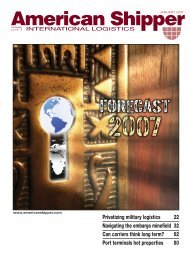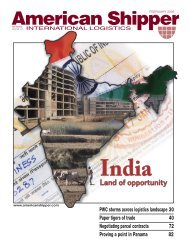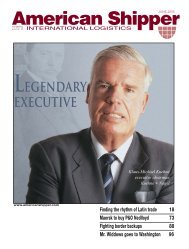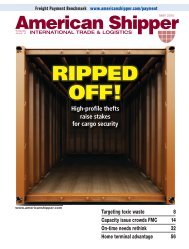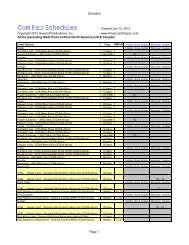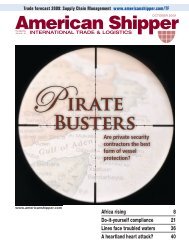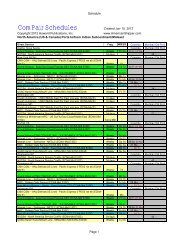McLean's - American Shipper
McLean's - American Shipper
McLean's - American Shipper
- No tags were found...
You also want an ePaper? Increase the reach of your titles
YUMPU automatically turns print PDFs into web optimized ePapers that Google loves.
TRANSPORT / OCEANthe Suez Canal is 118 miles long and 984feet wide at its narrowest point. Ships witha draft of up to 53 feet are allowed passage.The Suez Canal Authority has planned toincrease the permissible draft to 72 feetby 2010, which will allow the transit ofsupertankers.At present, supertankers can offloadpart of their cargo onto a canal authorityownedvessel, and reload at the other endof the canal.Today, there is one shipping lane throughthe canal that has several passing areas.Vessels transit northbound or southboundin tug-escorted convoys of 15 or 20 ships. Acomplete passage takes 11 to 16 hours.Usually, transits go smoothly. There areno locks to negotiate, nor periodic tidalsurges. However, sandstorms can disruptvessel convoys.Early in February, high winds whippedaround the Okal King Dor, a 93,000-tonHong Kong-flagged cargo vessel, causingthe ship to veer at right angles to the sidesof the canal. The ship wedged itself in place,blocking all transit until four tugs were sentto realign the vessel. Pushed back into theshipping lane, the Okal King Dor continuedits northbound passage.“They cleared that ship in less than a day,”said Anil J. Vitarana, president of UnitedArab Shipping Co. (S.A.G.), which hasits U.S. office in EastCranford, N.J.Vitarana’s company,a long-time customerof the Suez Canal,has had no recentcomplaints.“The canal operatesquite smoothly,” Vitaranatold <strong>American</strong>Vitarana<strong>Shipper</strong>. “As a carrier, you always feel thatthe tolls are too high. However, since we’vebeen paying at that scale, there haven’t beenany huge spikes. What increases there havebeen are moderate.”A pilot takes each ship through the canal.There’s also a husbanding agent who usuallytakes care of a vessel from a shoresidevenue.Operationally, the canal requires advancenotice of hazardous cargoes, “but not tosame extent that you now find with thePanama Canal,” Vitarana said. “You know24 hours in advance where your ship will beTable 2Suez Canal traffic1995-2005(In million tons, revenue in $billions)Year No. of Million SCAships tons revenue2005 18,193 671.8 $3.462004 16,850 621.1 $3.082003 15,667 549.3 $2.602002 13,447 444.8 $1.962001 13,986 456.0 $1.912000 14,141 439.0 $1.941999 13,490 385.0 $1.821998 13,471 386.0 $1.781997 14,430 368.7 $1.781996 14,731 354.9 $1.851995 15,015 360.2 $1.94Source: Suez Canal Authority.placed in a convoy. The length of the convoydepends on when your vessel reaches theforming point.”United Arab Shipping maintains an officein Alexandria, Egypt, to deal with thecompany’s vessels transiting the canal.In contrast to the Panama Canal Authority’spublic openness via a Web site andfrequent press releases, the Suez CanalAuthority — which is part of the Egyptiangovernment — prefers a profile as low asthe desert along the canal.The authority doesn’t have a public Website, nor even a restricted one for oceancarriers to use.“When the canal authorities do respond tous, to answer questions or discuss issues wemay have, they do that through our Egyptianagent,” Vitarana said. “Most carriers workin that way, through local agents. There’snot much direct communication with theauthority itself.”Ancient Routing. There has alwaysbeen a canal in the Suez region. PharaohSenusret III (1878 B.C.-1839 B.C.), in theEgyptian 12th Dynasty, is believed to haveordered a west/east canal dug through theWadi Tumilat to connect the Nile Riverwith the Red Sea. Such a canal definitelyexisted during the reign of Ramesses II inthe 13th century B.C.The Nile-Red Sea routing received a morepermanent canal in 500 B.C., completed byKing Darius I, the Persian conqueror of Egypt.Darius liked the work that was done enoughto erect granite stelae commemorating it.One such marker near Kabret, Egypt,reads as follows: “Saith King Darius: Whenthe canal had been dug as I ordered, shipswent from Egypt through this canal to Persia,as I intended.”In the centuries that followed, Darius’scanal was modified, destroyed, and rebuiltseveral times before the Abbasid Caliph al-Mansur wrecked it for good in the Eighthcentury A.D.Almost 1,000 years later, in 1856, Ferdinandde Lesseps, a former French consulin Cairo, obtained concessions from SaidPasha, the viceroy of Egypt, to build a canalbetween the Mediterranean and Red Sea thatwould be open to ships of all nations.Alois Negrelli, an Austrian engineer, drewup plans for the canal, and work started in1859. The project was completed in 1867.The canal had an immediate and dramaticeffect on global trade. It also became a pawnin precarious Egyptian politics. In 1888,the Convention of Constantinople declaredthe canal to be a neutral zone under Britishprotection.Under the Anglo-Egyptian Treaty of1936, the United Kingdom retained controlover the canal. That state of affairs lasteduntil 1951, when Egypt repudiated the treaty.By 1954, the United Kingdom had agreedto leave Egypt.In 1956, after the United Kingdom and theUnited States had withdrawn their supportfor construction of the Aswan Dam becauseEgypt sought weapons from the Soviet Union,Egypt’s President Gamal Abdel Nasserpromptly nationalized the Suez Canal.In the week-long Suez War that followed,Britain, France and Israel invaded Egypt.Enough ships were sunk to block passagethrough the canal until April 1957. Once thecanal was cleared, a United Nations forcewas created to maintain the neutrality of boththe canal and the entire Sinai Peninsula.After the Six-Day War in 1967, Egyptblockaded the canal and kept it closeduntil 1975. Today, a multinational forcecomprised mostly of U.S. troops monitorsthe Sinai. This armed presence is not partof the United Nations, but remains in placeunder agreements between the United States,Egypt and Israel.In 2006, vessels of all nations — includingIsrael — transit the Canal without politicsbeing a factor.Daily News UpdatesFeature Articles & Analysisamericanshipper.comYour subscription to <strong>American</strong> <strong>Shipper</strong> brings you both<strong>American</strong> <strong>Shipper</strong> Magazine66 AMERICAN SHIPPER: APRIL 2006



